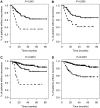The influence of sentinel lymph node tumour burden on additional lymph node involvement and disease-free survival in cutaneous melanoma--a retrospective analysis of 392 cases
- PMID: 18506141
- PMCID: PMC2441963
- DOI: 10.1038/sj.bjc.6604407
The influence of sentinel lymph node tumour burden on additional lymph node involvement and disease-free survival in cutaneous melanoma--a retrospective analysis of 392 cases
Abstract
Twenty per cent of sentinel lymph node (SLN)-positive melanoma patients have positive non-SLN lymph nodes in completion lymph node dissection (CLND). We investigated SLN tumour load, non-sentinel positivity and disease-free survival (DFS) to assess whether certain patients could be spared CLND. Sentinel lymph node biopsy was performed on 392 patients between 1999 and 2005. Median observation period was 38.8 months. Sentinel lymph node tumour load did not predict non-SLN positivity: 30.8% of patients with SLN macrometastases (> or =2 mm) and 16.4% with micrometastases (< or =2 mm) had non-SLN positivity (P=0.09). Tumour recurrences after positive SLNs were more than twice as frequent for SLN macrometastases (51.3%) than for micrometastases (24.6%) (P=0.005). For patients with SLN micrometastases, the DFS analysis was worse (P=0.003) when comparing those with positive non-SLNs (60% recurrences) to those without (17.6% recurrences). This difference did not translate into significant differences in DFS: patients with SLN micrometastasis, either with (P=0.022) or without additional positive non-SLNs (P<0.0001), fared worse than patients with tumour-free SLNs. The 2-mm cutoff for SLN tumour load accurately predicts differences in DFS. Non-SLN positivity in CLND, however, cannot be predicted. Therefore, contrary to other studies, no recommendations concerning discontinuation of CLND based on SLN tumour load can be deduced.
Figures

Similar articles
-
Sentinel lymph node micrometastasis may predict non-sentinel involvement in cutaneous melanoma patients.J Surg Oncol. 2008 Jul 1;98(1):46-8. doi: 10.1002/jso.21066. J Surg Oncol. 2008. PMID: 18452214
-
The prognostic significance of non-sentinel lymph node metastasis in cutaneous and acral melanoma patients-A multicenter retrospective study.Cancer Commun (Lond). 2020 Nov;40(11):586-597. doi: 10.1002/cac2.12101. Epub 2020 Oct 6. Cancer Commun (Lond). 2020. PMID: 33025763 Free PMC article.
-
Prediction of nonsentinel lymph node involvement in patients with a positive sentinel lymph node in malignant melanoma.Am Surg. 2007 Jul;73(7):674-8; discussion 678-9. Am Surg. 2007. PMID: 17674939
-
Sentinel lymph node biopsy in patients with primary cutaneous melanoma: study of 455 cases.J Eur Acad Dermatol Venereol. 2000 Jan;14(1):35-45. doi: 10.1046/j.1468-3083.2000.00005.x. J Eur Acad Dermatol Venereol. 2000. PMID: 10877250 Review.
-
The Role of Completion Lymphadenectomy in Positive Regional Lymph Nodes in Melanoma: A Meta-analysis.J Surg Res. 2019 Apr;236:83-91. doi: 10.1016/j.jss.2018.11.015. Epub 2018 Dec 7. J Surg Res. 2019. PMID: 30694783
Cited by
-
Therapeutic Value of Sentinel Lymph Node Biopsy in Patients With Melanoma: A Randomized Clinical Trial.JAMA Surg. 2022 Sep 1;157(9):835-842. doi: 10.1001/jamasurg.2022.2055. JAMA Surg. 2022. PMID: 35921122 Free PMC article.
-
Current management of melanoma patients with nodal metastases.Clin Exp Metastasis. 2022 Feb;39(1):181-199. doi: 10.1007/s10585-021-10099-7. Epub 2021 May 7. Clin Exp Metastasis. 2022. PMID: 33961168 Free PMC article. Review.
-
Validation of a clinicopathological and gene expression profile model for sentinel lymph node metastasis in primary cutaneous melanoma.Br J Dermatol. 2021 May;184(5):944-951. doi: 10.1111/bjd.19499. Epub 2020 Nov 2. Br J Dermatol. 2021. PMID: 32844403 Free PMC article.
-
Factors predictive of the status of sentinel lymph nodes in melanoma patients from a large multicenter database.Ann Surg Oncol. 2011 Dec;18(13):3593-600. doi: 10.1245/s10434-011-1826-9. Epub 2011 Jun 7. Ann Surg Oncol. 2011. PMID: 21647761 Free PMC article.
-
Enhanced postoperative lymphatic staging of malignant melanoma by endoscopically assisted iliacoinguinal dissection.Langenbecks Arch Surg. 2012 Mar;397(3):429-36. doi: 10.1007/s00423-011-0888-2. Epub 2011 Dec 24. Langenbecks Arch Surg. 2012. PMID: 22194038
References
-
- Balch CM, Soong SJ, Gershenwald JE, Thompson JF, Reintgen DS, Cascinelli N, Urist M, Mcmasters KM, Ross MI, Kirkwood JM, Atkins MB, Thompson JA, Coit DG, Byrd D, Desmond R, Zhang Y, Liu PY, Lyman GH, Morabito A (2001) Prognostic factors analysis of 17,600 melanoma patients: validation of the American Joint Committee on Cancer melanoma staging system. J Clin Oncol 19: 3622. - PubMed
-
- Cabanas RM (1977) An approach for the treatment of penile carcinoma. Cancer 39: 456. - PubMed
-
- Carlson GW, Murray DR, Lyles RH, Staley CA, Hestley A, Cohen C (2003) The amount of metastatic melanoma in a sentinel lymph node: does it have prognostic significance? Ann Surg Oncol 10: 575. - PubMed
-
- Cascinelli N, Bombardieri E, Bufalino R, Camerini T, Carbone A, Clemente C, Lenisa L, Mascheroni L, Maurichi A, Pennacchioli E, Patuzzo R, Santinami M, Tragni G (2006) Sentinel and nonsentinel node status in stage IB and II melanoma patients: two-step prognostic indicators of survival. J Clin Oncol 24: 4464. - PubMed
-
- Cochran AJ, Balda BR, Starz H, Bachter D, Krag DN, Cruse CW, Pijpers R, Morton DL (2000) The Augsburg Consensus. Techniques of lymphatic mapping, sentinel lymphadenectomy, and completion lymphadenectomy in cutaneous malignancies. Cancer 89: 236. - PubMed
MeSH terms
LinkOut - more resources
Full Text Sources
Medical

